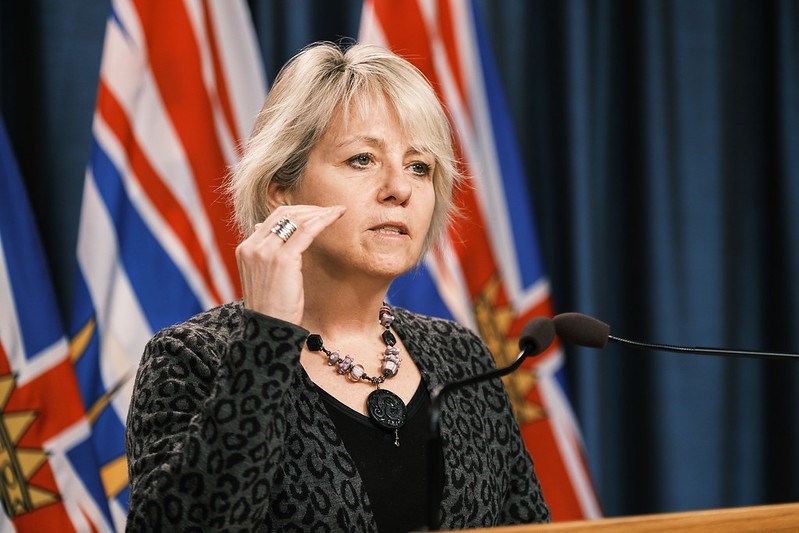B.C.’s top doctor has extended restrictions on social gatherings, but says if transmissions continue to decrease, British Columbians could again interact in small bubbles and attend religious services by the end of the month.
Provincial health officer Dr. Bonnie Henry said the province has seen a downward trajectory in new cases of COVID-19, and a dramatic and sustained decrease in illness among the most elderly, who are most susceptible to severe illness.
“We are bending our curve, slowly and steadily,” Henry said, “but we need to protect the progress we have made since the start of this year, and not squander our success.”
The province reported 471 new cases on Friday, including 28 in Island Health, and six new deaths.
Henry said she is leaving the date for when restrictions will end open while she monitors new case numbers.
The goal is to maintain the downward trajectory of new cases and immunize more people while ramping up testing for highly transmissible COVID-19 United Kingdom and South African variants, Henry said.
“Just one super-spreader event could see new cases of COVID-19 spike again and undo work underway to see people immunized,” said Henry, who presented models of COVID-19 case growth rates, hospitalizations and deaths on Friday. “Each holiday and vacation this month, whether it’s the Super Bowl this Sunday, Lunar New Year, Family Day, Valentine’s Day, it’s an important opportunity for us to either allow the virus to spread, or to slow it down even more.”
This week, 3,061 people tested positive for the virus in the province, of whom 108 were hospitalized.
The majority of new cases are related to local clusters, but there are still some connected to international travel, which is of concern, said Henry.
Province-wide, the reproduction number for the virus — infections generated by each new case — has fallen below one. Whenever the reproductive number is more than one, there is a risk that the number of new cases could grow rapidly, Henry said.
“The good news here is that despite being at or above one for much of the last few months … we’ve seen that curve [go] down again,” she said.
As of Thursday, B.C. Centre for Disease Control labs had found 19 cases of the U.K. variant in B.C. Fourteen travelled directly from the U.K., Ireland and Dubai and other countries, while five were close contacts. There have also been nine cases of the South African variant — one was acquired via travel, while three were contacts of an infected person and five were acquired in the community.
Each week, B.C. scans 750 whole genome sequences of positive COVID-19 tests — those who have travelled internationally, those who are part of an outbreak, and random samples — to detect the variants. It is working toward being able to do “thousands” a week.
Continuing the ban on social gathering first imposed in November is needed to buy time to get B.C.’s immunization program back running at full speed, Henry said.
Canada is getting about one-fifth of the Pfizer-BioNTech vaccine shipments planned for this week and next as the company’s plant in Belgium is revamped to crank out more doses. The Moderna vaccine, the second of two vaccines approved for use in Canada, is anticipated to be 50,000 doses short of what had been expected after production delays in Switzerland.
Prime Minister Justin Trudeau said Canada still expects to receive six million doses of vaccine by the end of March and to offer the vaccine to every Canadian who wants it by September.
To date, 149,564 vaccines — both Pfizer and Moderna — have been administered in B.C., including to 87 per cent of long-term care residents. As well, 13, 047 doses of vaccine have been administered in remote and isolated First Nations communities. B.C. Health Minister Adrian Dix said he’s confident of hitting a target of 25,000 doses by the end of March.
Between Dec. 20 and Feb. 4, there were 205 so-called adverse events following immunization, 55 of which are classified as serious — anaphylaxis, for example. For every 10,000 doses administered, there are about 14 adverse events.
Allergic reactions are expected and are being carefully monitored, Henry said.
Data from Aug. 1, 2020 to Feb. 3 shows new case counts are by far highest in the 20-29 age group, followed by those 30-39 and then 40-49.
“It’s people between the ages of 20 and 49 which are driving the pandemic at this point,” Henry said, noting the source of transmission is a mix of social interactions and workplace transmission.



